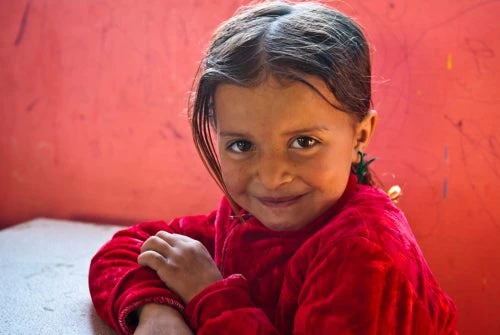
Les inégalités se manifestent très tôt. Dans la région du Moyen-Orient et de l’Afrique du Nord (MENA), elles apparaissent avant la naissance, parce que les soins prénatals ne sont pas offerts à tous, et perdurent dans la jeune enfance, selon le degré d’accès aux nutriments essentiels à une bonne alimentation, aux services de santé et à l’éducation préscolaire. Se priver de l’un ou l’autre de ces facteurs clés de développement, c’est prendre le risque de désavantager irrémédiablement un enfant pendant toute sa scolarité et plus tard dans sa vie d’adulte, avec la possibilité de voir ces inégalités ancrées dès le plus jeune âge rejaillir sur la génération suivante, créant un cercle vicieux de pauvreté. Les auteurs d’un
nouveau rapport de la Banque mondiale ont calculé les chances d’un développement équilibré pour un enfant de la région issu des 20 % de foyers les plus démunis (que l’on désignera ci-dessous par « enfant le moins favorisé ») et pour un enfant de la région issu des 20 % de foyers les plus riches (ou « enfant le plus favorisé »).
- En Algérie, les enfants à naître les moins favorisés ont 52 % de chances de recevoir des soins prénatals, contre 99 % chez les plus favorisés.
- À Djibouti, les enfants les moins favorisés ont 46 % de chances de bénéficier d’un accouchement réalisé avec du personnel qualifié, contre 100 % pour les plus favorisés.
- En Égypte, les enfants les moins favorisés ont 2,8 % de chances de décéder avant leur premier anniversaire, contre 1,1 % chez les plus favorisés.
- En Iraq, les enfants les moins favorisés ont 34 % de chances de bénéficier d’une vaccination complète à la date de leur premier anniversaire, contre 91 % chez les plus favorisés.
- En Jordanie, les enfants les moins favorisés ont 29 % de chances de souffrir d’un retard de croissance dû à une malnutrition, contre 2 % chez les plus favorisés.
- Au Liban, les enfants les moins favorisés ont 12 % de chances de bénéficier d’une vaccination complète à la date de leur premier anniversaire, contre 79 % chez les plus favorisés.
- En Libye avant les troubles actuels, les enfants les moins favorisés avaient 40 % de chances d’avoir accès à du sel iodé, indispensable au développement cognitif, contre 73 % chez les plus favorisés.
- Au Maroc, les enfants les moins favorisés ont 25 % de chances de souffrir d’insuffisance pondérale, contre 2 % chez les plus favorisés.
- En Syrie avant la crise, les enfants les moins favorisés avaient 2 % de chances d’aller en maternelle ou à la crèche avant l’âge de cinq ans, contre 69 % pour les plus favorisés.
- En Tunisie, les enfants les moins favorisés ont 4 % de chances d’aller en maternelle ou à la crèche entre l’âge de trois et quatre ans, contre 92 % pour les plus favorisés.
- Dans les territoires palestiniens, les enfants les moins favorisés ont 17 % de chances de souffrir d’un retard de croissance dû à une malnutrition, contre 6 % chez les plus favorisés.
- Au Yémen avant la crise, les enfants les moins favorisés ont 15 % de chances de bénéficier d’une vaccination complète, contre 88 % pour les plus favorisés.
Les investissements qui ciblent la jeune enfance dans le but de promouvoir l’égalité d’accès à des services clés dans les domaines de la santé, de l’alimentation et de l’éducation pourraient changer la vie de millions d’enfants dans la région MENA. Ces investissements contribuent également à rompre le cercle vicieux de la pauvreté, en veillant à ce que les germes de l’inégalité ne s’enracinent pas définitivement lors des premières années de la vie.
 Les inégalités se manifestent très tôt. Dans la région du Moyen-Orient et de l’Afrique du Nord (MENA), elles apparaissent avant la naissance, parce que les soins prénatals ne sont pas offerts à tous, et perdurent dans la jeune enfance, selon le degré d’accès aux nutriments essentiels à une bonne alimentation, aux services de santé et à l’éducation préscolaire. Se priver de l’un ou l’autre de ces facteurs clés de développement, c’est prendre le risque de désavantager irrémédiablement un enfant pendant toute sa scolarité et plus tard dans sa vie d’adulte, avec la possibilité de voir ces inégalités ancrées dès le plus jeune âge rejaillir sur la génération suivante, créant un cercle vicieux de pauvreté. Les auteurs d’un
nouveau rapport de la Banque mondiale ont calculé les chances d’un développement équilibré pour un enfant de la région issu des 20 % de foyers les plus démunis (que l’on désignera ci-dessous par « enfant le moins favorisé ») et pour un enfant de la région issu des 20 % de foyers les plus riches (ou « enfant le plus favorisé »).
Les inégalités se manifestent très tôt. Dans la région du Moyen-Orient et de l’Afrique du Nord (MENA), elles apparaissent avant la naissance, parce que les soins prénatals ne sont pas offerts à tous, et perdurent dans la jeune enfance, selon le degré d’accès aux nutriments essentiels à une bonne alimentation, aux services de santé et à l’éducation préscolaire. Se priver de l’un ou l’autre de ces facteurs clés de développement, c’est prendre le risque de désavantager irrémédiablement un enfant pendant toute sa scolarité et plus tard dans sa vie d’adulte, avec la possibilité de voir ces inégalités ancrées dès le plus jeune âge rejaillir sur la génération suivante, créant un cercle vicieux de pauvreté. Les auteurs d’un
nouveau rapport de la Banque mondiale ont calculé les chances d’un développement équilibré pour un enfant de la région issu des 20 % de foyers les plus démunis (que l’on désignera ci-dessous par « enfant le moins favorisé ») et pour un enfant de la région issu des 20 % de foyers les plus riches (ou « enfant le plus favorisé »).


Prenez part au débat